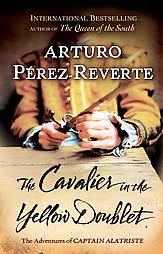By Paul Carrier
Diego Alatriste, the jaded but principled hero of four previous novels by Spanish author Arturo Pérez-Reverte, returns in The Cavalier in the Yellow Doublet. But this time, Alatriste, a weary army veteran and swordsman for hire in 17th-century Spain, may find himself up against an opponent far too dangerous even for him.
Madrid, with its dark streets, abandoned alleys, dingy taverns and glittering palaces, is as much a character here as Alatriste and his protégé, the young narrator Inigo Balboa, who is infatuated with the dangerous Angélica de Alquézar, a lady in waiting to the queen.
For his part, Alatriste is smitten by Maria de Castro, a beautiful actress who, unfortunately for him, also has caught the eye of Philip IV, the king of Spain. When Alatriste is implicated in a plot to assassinate the king, his problems mount and the novel gallops to its dramatic conclusion.
The American reader is at a bit of a disadvantage here because The Cavalier in the Yellow Doublet introduces us to real-life historical figures who are far more familiar to Spaniards than to Americans, such as poets Félix Lope de Vega and Francisco Gomez de Quevedo and Gaspar de Guzman y Acevedo, the prime minister under Philip IV.
But that is a small hurdle, easily overcome. Pérez-Reverte’s graceful style transports the reader to Spain's golden age. It is a world that combines the power of empire, the elegance of the royal court, the arrogance of "hidalgos" and "grandees," the riches of the Americas and the intolerance of the Inquisition.
This is a place where sword and dagger are as much a part of a man's costume as a cloak and a wide-brimmed hat, the better to protect him from a chilly fog and shield his face from prying eyes.
To borrow a phrase from Elvis Costello, who uses it in an entirely different context in one of his songs, Alatriste’s world is awash in “complicated shadows.”
If this conjures up images of The Three Musketeers, the comparison is inevitable, and appropriate. The time period is the same, although Alexandre Dumas' musketeers swagger their way through France, not Spain, In both cases, though, 17th-century concepts of honor, duty and machismo shepherd the protagonists through a world filled with treachery and deceit.
The fictional Alatriste is one of Spain's greatest swordsmen, so there is no shortage of clashing steel in The Cavalier in the Yellow Doublet. By page 70, for example, Alatriste has survived two sword fights, in the process wounding at least two men and possibly killing a third.
Still, it would be misleading to suggest that The Cavalier in the Yellow Doublet is all swashbuckling and swordplay. There is a brooding quality to the Alatriste novels, and this latest effort is no exception.
Pérez-Reverte offers a convincing portrait of 17th-century Spain, in part by sprinkling the text with snippets of poetry that provide an evocative sense of time and place. This is fine stuff, well-written and nicely plotted.
If you're new to the series, I'd suggest reading the novels in the order in which they were published, as they proceed chronologically. The first in the series is Captain Alatriste.

